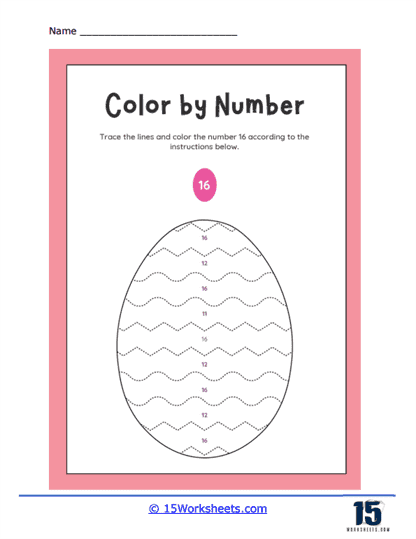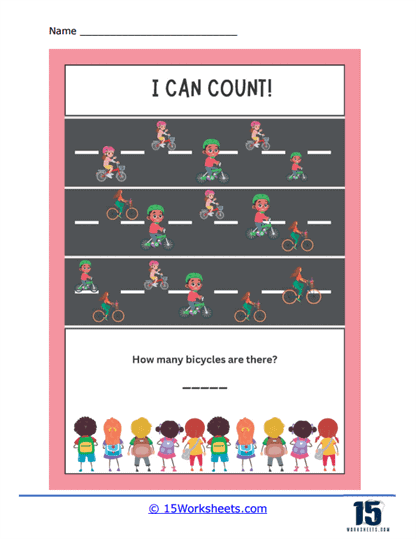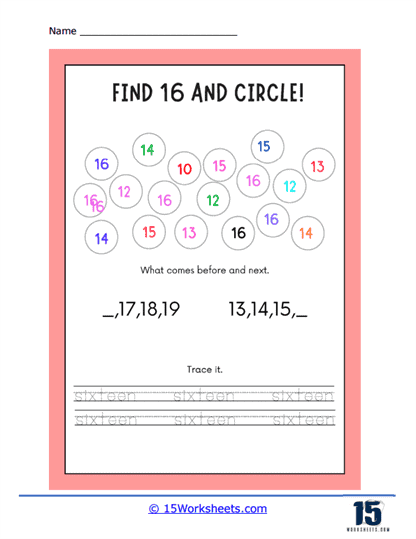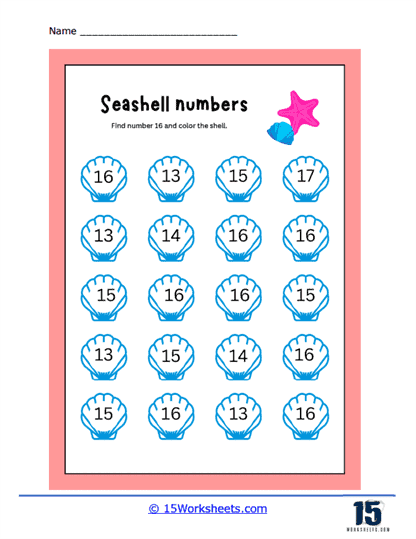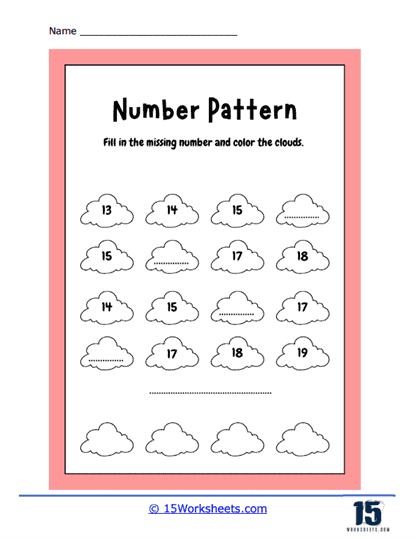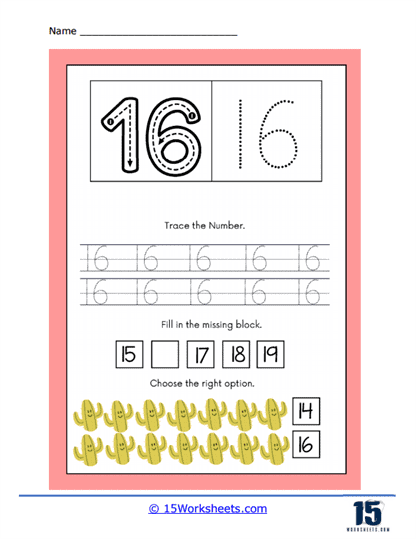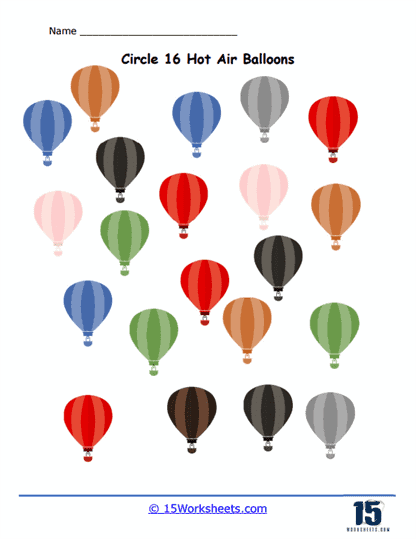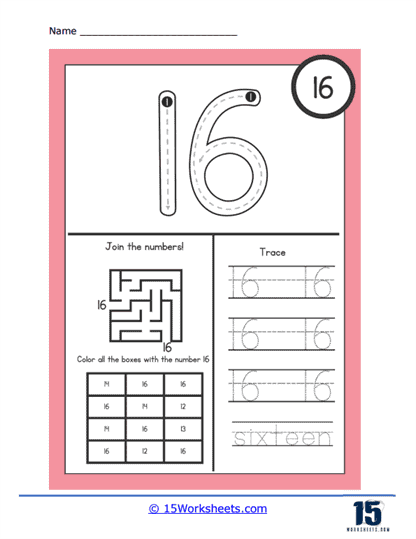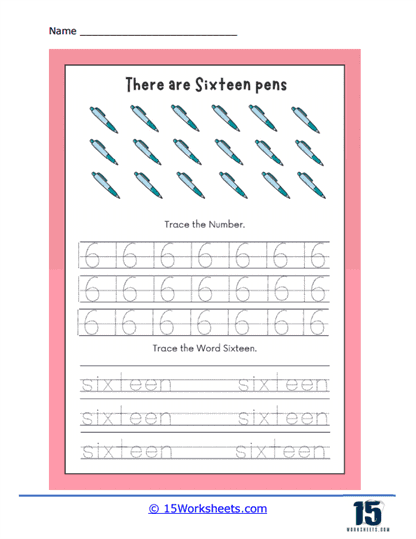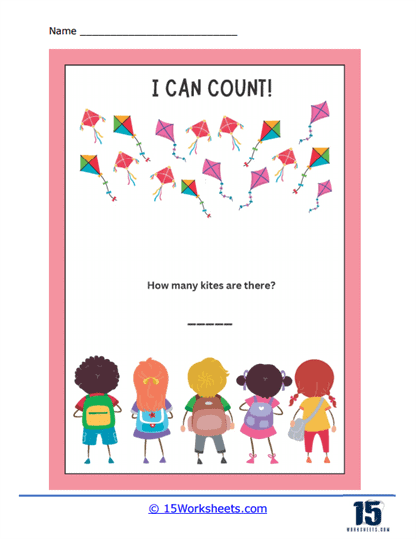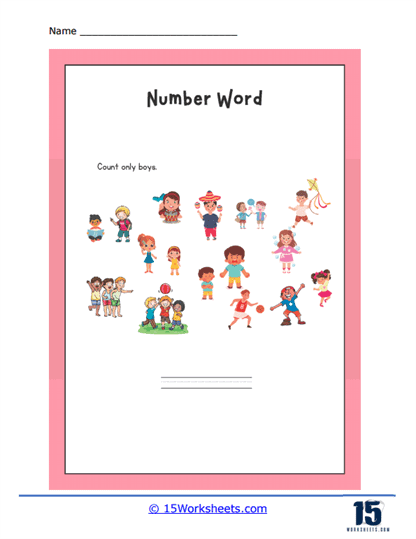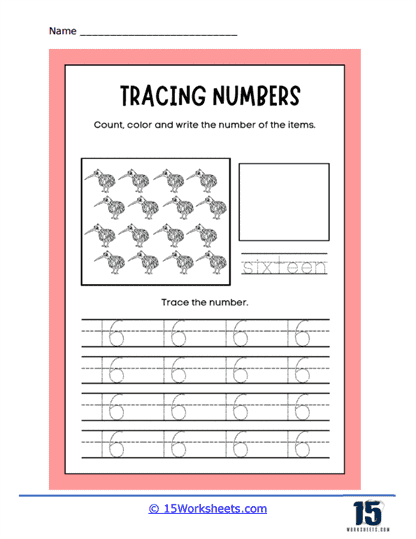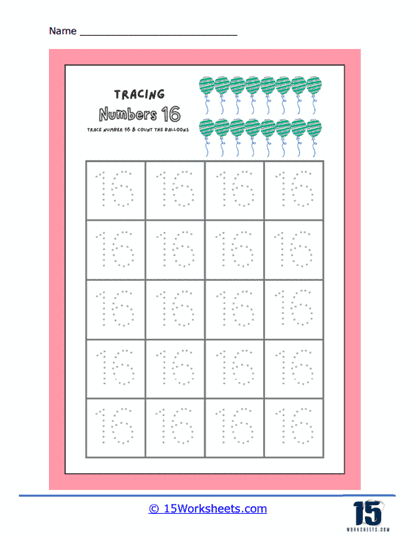Number 16 Worksheets
About These 15 Worksheets
Imagine you’re playing a game where you’re asked to recognize different shapes or colors. At first, this may feel challenging, as your brain works to quickly sort through the shapes or hues in front of you. However, as you continue to play and repeat the task, you find yourself improving. The more you practice, the faster you can identify each shape or color, almost without thinking. This happens because repetition builds familiarity. Your brain begins to recognize patterns and shortcuts, helping you process information more quickly and with greater accuracy. Over time, this continuous exposure strengthens your ability to understand and remember. The same principle applies when learning numbers, particularly with something as specific as the number 16.
Number 16 worksheets serve as a structured, engaging way to focus on this number, much like the game teaches you to recognize shapes or colors. These worksheets are not just ordinary exercises; they are carefully designed to revolve around the number 16 in creative and interactive ways. Think of them as a toolbox full of fun activities aimed at helping you become more comfortable with this number. For instance, you might be asked to count up to 16 using various objects-whether they’re apples, toy cars, or other familiar items from everyday life. Another activity could involve identifying the number 16 hidden among other numbers, challenging your mind to single it out, just as you would look for a specific shape in the game.
Beyond just recognition, number 16 worksheets may ask you to perform basic arithmetic, like adding or subtracting to arrive at the number 16. This not only enhances your understanding of the number itself but also deepens your familiarity with how numbers relate to one another. You might even practice writing the number 16 repeatedly, which reinforces both the symbol and its meaning in your mind. Through these varied exercises, your brain starts to view the number 16 as more than just a static figure; it becomes a dynamic concept that you can manipulate, understand, and apply in different contexts.
The ultimate goal of these worksheets is to improve something known as “number sense.” Number sense refers to your intuitive understanding of how numbers work and how they interact with each other in the mathematical world. Developing strong number sense means being able to quickly grasp ideas like the fact that 16 is greater than 10 but less than 20, or that two groups of 8 add up to make 16. These are simple ideas on the surface, but they lay the groundwork for more complex mathematical thinking. Just like how recognizing shapes and colors in a game becomes second nature with practice, building number sense through focused activities like number 16 worksheets helps you think more naturally and confidently about numbers.
By repeatedly engaging with these worksheets, you’re not just memorizing facts about the number 16-you’re fostering a deeper, more intuitive grasp of numerical relationships. Much like how you grow better at recognizing patterns in a game, the exercises help you to internalize the logic and rules that govern numbers, making you a more proficient and confident problem solver in the long run. Whether you’re just starting to learn about numbers or seeking to refine your skills, number 16 worksheets offer a fun, effective way to sharpen your mathematical abilities while making learning enjoyable.
Types of Exercises
Worksheets designed around the number 16 can take many different forms, but they often share a common goal: to help children develop a strong foundational understanding of this specific number through a variety of engaging activities. These exercises are carefully crafted to not only teach the numeral’s shape and significance but also to introduce broader mathematical concepts in an approachable way. Here’s a closer look at some of the common activities you might find in a number 16 worksheet:
One of the key components of such worksheets is Number Tracing, where children are asked to trace the numeral “16” repeatedly. This activity serves a dual purpose. First, it helps children become familiar with the shape and structure of the number, allowing them to recognize it more easily in the future. Second, it reinforces fine motor skills, which are essential for early writing development. The act of tracing encourages muscle memory, which aids children in writing numbers independently with greater precision and confidence.
Another common activity is Counting, where children are presented with a set of objects, such as images of fruits, animals, or geometric shapes, and asked to count how many items are in the set. Once they have identified 16 objects, they write the numeral “16” to represent the total. This exercise not only strengthens counting skills but also helps children connect the abstract symbol of the number with real-world quantities, deepening their understanding of what the number 16 represents. By visually associating the number with a countable quantity, children gain a more concrete sense of its meaning, which is crucial for developing number sense.
Worksheets may also include a Coloring or Highlighting task, where children are instructed to select and color a specific number of objects, such as 16 flowers in a larger field of flowers. This type of activity fosters attention to detail and reinforces the concept of quantity. By isolating and highlighting a specific number of items within a larger group, children practice focusing on one-to-one correspondence, ensuring that each object counted represents exactly one unit. This practice helps solidify their understanding of how numbers function in relation to groups of objects, which is a key step in learning how to count and compare different quantities.
Another essential component is Number Identification exercises. These worksheets often feature a mix of numerals, and children are tasked with identifying and circling or coloring the number 16 wherever it appears. This activity is particularly useful for sharpening a child’s ability to differentiate between numbers and reinforces their ability to quickly recognize the numeral 16 among other numbers. It helps children hone their visual discrimination skills, a critical aspect of early numeracy, as it ensures they can identify numbers in different contexts and formats.
The Sweet Significance of 16
The number 16 has fascinated mathematicians, scientists, and historians for centuries due to its unique properties and appearances across a wide range of fields. To begin with, 16 is a perfect square, the result of 4 multiplied by itself. This simple fact holds considerable mathematical significance, as perfect squares often represent symmetry and balance in geometry and algebra. In ancient civilizations, the number 16 was particularly revered because of its appearance in measurements. For example, the Babylonian number system, which used a base of 60, often employed multiples of 16 in architecture and astronomy, reflecting the value placed on numbers that could easily divide larger figures. The square root of 16, which is 4, represents stability, making the number 16 especially symbolic of order and structure in mathematical systems.
In the realm of science, 16 is essential to our understanding of nature and the world around us. A particularly interesting fact is that 16 is the atomic number of sulfur, a vital element for life on Earth. Sulfur is found in everything from proteins to volcanic gases, and it has played an important role in chemistry and industry for centuries. Ancient alchemists believed sulfur was one of the three basic elements of matter, alongside mercury and salt. Furthermore, in physics, 16 is the number of known fundamental particles in the Standard Model (when counting quarks, leptons, and their corresponding antiparticles). These particles make up the building blocks of all matter, which adds to the scientific relevance of the number 16 in understanding the universe.
Beyond its mathematical and scientific properties, the number 16 has also appeared throughout history and culture in interesting ways. In many cultures, turning 16 is seen as a coming-of-age milestone. In the United States and many other countries, reaching the age of 16 is often associated with newfound freedoms, such as the ability to drive a car, work certain jobs, and gain a greater sense of independence. This rite of passage is often celebrated with great fanfare, and the “sweet sixteen” party is a tradition that dates back to earlier centuries when young people were considered ready to start taking on more adult responsibilities. This cultural significance of 16 as an age of transition and growth ties into the symbolic meaning of the number itself, as it marks a point of maturity and readiness.
In computing, the number 16 plays an essential role due to its relationship with the binary system, which is the foundation of how computers process information. In hexadecimal notation, which is base-16, each digit can represent values from 0 to 15, making it a concise way of handling large binary numbers. Hexadecimal is widely used in computer programming, particularly in coding for colors, where a 6-digit hexadecimal code can represent over 16 million different colors. This connection to computers highlights how the number 16, in its different forms, is integral to modern technology and communication systems. From ancient measurements to modern digital coding, the number 16 has remained a key player in shaping human understanding and progress.


